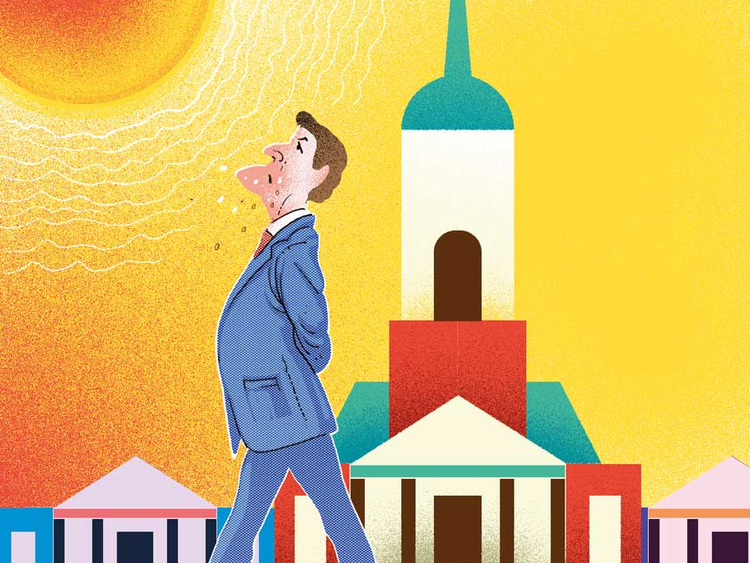One thing you can say about the Underground system in London is that is it the quickest way of getting around the city of 10 million. But the quickest does not equate with the most comfortable. As summer temperatures have soared across northern Europe — meteorologists are predicting the mercury could hit 50 degrees Celsius in parts of southern Spain and Portugal now, the hottest temperatures recorded there since weathermen started keeping track of such things. As a result, it’s got downright stinky and hot riding the Tube.
Because London and the United Kingdom generally aren’t used to such hot summers — the last one nearly as warm and for nearly as long was back in 1976, the previous in 1961 — there is no air-conditioning as the trains on the District, Circle, Piccadilly lines and the rest trundle through the bowels of what feels like the outer circles of Hell, given the stifling temperatures.
In northern England, there hasn’t been anything like normal rainfall for months, and farmers who are hard-pressed to give their herds of livestock sufficient water have been granted special permission to take more supplies from rivers.
Canals that cross the nation used to be the mainstay of the transportation system before the advent of railways. Now, those canals are running low on water, the lock systems to raise and low narrowboats from one level to the next aren’t functioning, and those boats are scraping off the beds of the waterways anyway.
In Manchester, the water shortage has also highlighted a fact that for every litre of water in the pipes under the roads and footpaths, half of it is lost in leaks and poorly maintained infrastructure.
If there is one plus in this litany of summer woes, it is that archaeologists have taken to the skies above England and, because of the wilting fields and virtually non-existent moisture content, have been able to distinguish the outlines of long-lost Roman and Saxon settlements in those parched pastures.
In Ireland, a nation that’s normally known for its greener-than-green grass and its gloomy clouds and intermittent rain, there’s a drought. Householders in Dublin and other cities have been prohibited from watering their lawns, and the water works authority has asked people to refrain from anything that might use up dwindling water sources.
In the Irish agricultural system, the nation’s dairy farmers are expected to see their annual incomes cut by half because of the weather.
Earlier this week, temperatures in Germany got so hot that fish in the River Rhine simply stopped swimming and died. In two days alone, a quarter of the annual permissible fish catch that’s normally taken from the waterway by fishermen and anglers was simply lost because the fish simply floated to the surface and gave up in the bath-like water.
In Switzerland, cows have died of thirst and grass growth is so poor now on those Alpine slopes, Swiss authorities are permitting the importation of hay for fodder from Germany and Austria.
In Sweden, a nation known for its forestry and timber products, summer fires spawned by the high temperatures have consumed 20,000 hectares of woodland, and the summer heat has changed the official high point of that nation because the glacier tip on Mount Kebnekaise melted. Its summer berry season is a write-off, it’s simply too hot for the fruits to come to fruition.
Around the Mediterranean, it’s even hotter, with pavements on some Spanish and Portuguese roads breaking up as the asphalt surface melted.
But it’s not just Europe that’s experience hot temperatures. In Quebec, some 70 people died there in July as a direct result of summer temperatures exceeding 40 degrees Celsius.
Sure, for readers of Gulf News in the Arabian Gulf, the temperatures in Europe and the hot and prolonged summer conditions might raise an eyebrow — and certainly readers from the Indian subcontinent might be used to such extreme climatic conditions. The reality is that Europeans are not. And nor is their infrastructure, economies, agricultural production systems, road and transport networks, trains or even canals.
Yes, climate analysts have said that 2018 will be the hottest year on record, with some towns inside the Arctic Circle recording unprecedented temperatures of above 30 degrees Celsius.
Not only are temperatures higher, but weather patterns are also more erratic. Across France, there have been severe thunderstorms, with so much rain falling so quickly that drainage and retention systems are overwhelmed. Simply put, there’s too much rain falling too quickly for it to be used to end the alternative periods of drought experienced there.
The Dutch, who for centuries have fought a battle with Mother Nature to prevent the sea from inundating their lands, now find themselves with too little water in their dykes, undermining the carefully crafted and engineered system that keeps the sea out.
Sure, everyone loves a sunny summer. Now the question every European must face is when is too much sun too much?
2018 must go down as the year when the effects of climate change and global warming became a reality.
Ten years ago, the European Union first set out to try and tackle climate change, and the 28 members have broadly adopted the “Triple 20” strategy by 2020, pledging to cut greenhouse gases by 20 per cent, increasing its share of renewable energy by 20 per cent, and increasing energy efficiency by 20 per cent.
For environmentalists and climate-change advocates, who point to this summer as a need for urgent and more extensive change, the Triple 20 is too low. The reality, though, is that change happens slowly in Europe. Hopefully, the events of this simmer from the Baltic to the Balearics, the Canary Islands to Central Europe, might just be enough for more urgent action.
Now, all a climate denier has to do is simply take a Tube train from Euston to Embankment to experience first-hand what global warming feels like. And we’d better get used to it.









